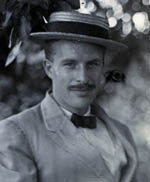
1887–1969
-
Geophysical Laboratory, staff member (1910-1936)
-
Geophysical Laboratory, acting director (1936-1937)
-
Geophysical Laboratory, director (1938-1952)
-
B. S., University of Illinois, 1906
-
Sc.D., Tufts University, 1941
-
National Academy of Sciences
-
American Physical Society, fellow
-
Geological Society of America, fellow
-
American Geophysical Union, vice-president, president
-
Royal Astronomy Society, fellow
-
International Union of Geodesy and Geophysics, vice-president
-
Washington Academy of Sciences, president
-
Philosophical Society of Washington, president
-
Cosmos Club, president
-
Longstreth Medal, Franklin Institute
-
Medal for Merit, United States Government Reserve
-
Bowie Medal, American Geophysical Union
|
Leason H. Adams arrived at the Geophysical Laboratory as a physical chemist in 1910 with initial interests in chemical thermodynamics. In his early work, he and his colleagues, E. D. Williamson and G. W. Morey, studied the original works of J. Willard Gibbs. As John Johnston’s research assistant, Adams researched the effects of pressure and temperature on the behavior of physicochemical systems. At the time of his early work, highly accurate scales for measuring high pressure were still undeveloped. To overcome this obstacle, Adams was extremely meticulous in his work and record-keeping and strived continuously to invent a method for the consistent and accurate determination of pressure and temperature. He and Johnston made an early attempt to measure the thermal gradient of the Earth’s crust. In 1912, they lowered thermometers down wells in West Virginia to depths of 5,230 feet. By 1924, building on the work of Holmes and Jeffreys on the cooling of the Earth, Adams extended the geotherm down to 300 kilometers. Adams’ studies were interrupted in 1917 by World War I and the Geophysical Laboratory’s involvement in optical glass research. Adams and Williamson adopted a fundamental approach toward the physics of glass production, and their results were consequentially implemented by the industry. For this pioneering work, Adams received the Edward Longstreth Medal of the Franklin Institute in 1924. For more information regarding the Geophysical Laboratory's involvement in optical glass research, please see The Optical Glass Rivalry. |
|||
|
|
|||
|
|||
|
|
|||
|
In 1936, Adams assumed the title of acting director at the Geophysical Laboratory after Arthur L. Day, the Laboratory’s first director for almost thirty years, retired. He became director a year later. When World War II began in Europe, Adams placed his and the Laboratory’s talents at the service of the nation. In June of 1941, he was appointed chairman of Section A, Division A, of the National Defense Research Committee. The Laboratory’s task was to study the erosion of gun barrels caused by the action of hot propellant gases under high pressure and the rapid travel of projectiles along the bores of guns. This was a significant problem for the United States military at the time because gun erosion placed increasing restrictions on the usable life of guns. To solve the problem, Adams appointed a group of scientists and engineers to conduct research on gun barrels. The assembly’s results were fast and led to vast advancements in ordnance that were soon adopted by the armed services. Adams and his team’s work did not go unnoticed, as he was awarded the Presidential Medal for Merit in 1948 for his amazing leadership and ground-breaking study. With the war finally over, Adams again resumed his research on the effects of high pressure and temperature on the properties of rocks and minerals. This time, he was joined by Hatten S. Yoder, Jr., who would later become director of the Geophysical Laboratory, on the design for an apparatus capable of measuring the thermodynamic properties of solids including polymorphic transitions at pressures up to 12,000 bars and temperatures above 600 degrees Celsius. Adams retired in 1952, and served as a technical consultant to the National Bureau of Standards regarding the measurement and interpretation of the effects of high pressures on a number of different materials. In 1957, he accepted the position of visiting professor of geophysics in the Institute of Geophysics and Planetary Physics at the University of California at Los Angeles. He returned to Washington from California in March of 1965. Between his return move and his death and 1969, Adams lived peacefully at home. R. E. Gibson remembered Adams as “a gregarious man. He loved to exchange ideas and match wits with his fellows. Those who once tasted his soft spoken humor, his ready wit, and his encyclopedic knowledge gave him every opportunity to do so. He found outlets for these propensities in many ways…” |
|||
|
|
|||
|
References:
Further Reading:
|

